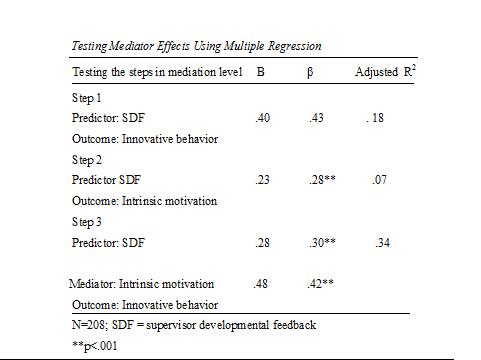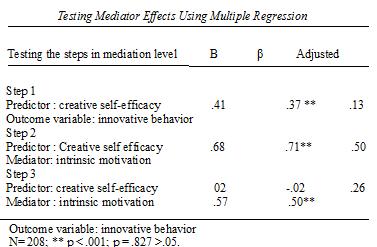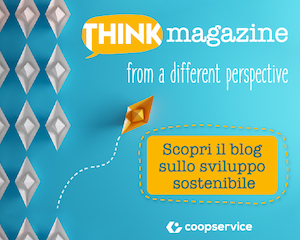Leadership, Creativity & Innovation: RESULTS
Leadership, Creativity & Innovation: RESULTS
Table 1 displays means, standard deviations, and inter correlations among all study variables.
Table 1.

** Correlation is significant at the 0.01 level (2-tailed).
CONSTRUCT VALIDITY.
According to Bartlett’s test, the matrix is not an identity matrix. The null hypothesis is rejected. The variables under analysis are correlated, thus factor analysis is justified. The Cumulative percentage is 61. 139. Four factors explain 61.139% of common variance.

Besides the reversed item of supervisor developmental feedback, all of the variables had values higher than 0.4. It had no loading on any factor that made weaker the correspondence between the structure of a set of indicators and the construct it measures.
RELIABILITY
Alpha Cronbachs for almost all of the measures were higher than .70. Removal of any item or set of items in any measure did not appreciably improve estimates of internal consistency. So, all the variables used in the research were internally consistent. Separately measured they registered high alpha coefficients.
In the table below the alpha coefficients are presented for all of the variables.

A reversed item, supervisor developmental feedback, turned out to have slightly higher value than Alpha coefficient. Nevertheless, a review of all of the scales together reveals that a high reliability was registered (.913).
GUIDE FOR TESTING THE METIATION EFFECTS IN MULTIPLE REGRESSION
To test the mediating effect, multiple regression analysis was run to analyze the relationship among all of the variables by first regressing the dependent variable on the independent variable, then regressing the mediator on the independent variable, and finally regressing the dependent on both the independent variable and the mediator variable ( Baron & Kenny, 1986).
According to the authors (Baron & Kenny, 1986; Judd & Kenny, 1981) there are four steps in establishing that a variable (intrinsic motivation) mediates the relation between a predictor variable and the outcome variable : by first step is shown that there is a significant relation between the predictor and outcome. The second step is to show that the predictor is related to the mediator. Third step is to show that the mediator (intrinsic motivation) is related to the outcome variable (innovative behavior). The final step is to show that the strengths of the relation between the predictor and the outcome is significantly reduced when the mediator is added to the model.
Hypothesis 1: Supervisor developmental feedback is positively related to innovative behavior through the mediating role of intrinsic motivation.
Table 1

Table 1 provides the results of analysis to test the meditational hypothesis. The unstandardized regression coefficient (.40) related to the effect of supervisor developmental feedback was significant. (p<.0001). Thus, the supervisor developmental feedback and the requirement for the mediation in step 1 was met.
As mentioned above mediator variable (intrinsic motivation) on predictor variable (supervisor developmental feedback) was regressed in step 2.
The unstandardized regression coefficient (B=.23) related with this relation also was significant at the p<.0001 level. Thus the condition for step 2was supported, supervisor developmental feedback was again significant.
Further, to test whether mediator variable (intrinsic motivation) was related to outcome variable (innovative behavior) we regressed the latter simultaneously on both (mediator) intrinsic motivation and predictor (supervisor developmental feedback). The coefficient concerning the relation between intrinsic motivation and supervisor developmental feedback also was significant. (B= .28, p<.0001). Thus, the condition for step 3 was again supported. (supervisor developmental feedback was significant).
This third regression equation also provided an estimate of the relation between predictor and outcome variable. If B equals zero in that relation, there is complete mediation. However, that path was .48 and still significant (p<.0001).
It means that the relationship between the predictor (supervisor developmental feedback) and the outcome variable (innovative behavior) is partially mediated by intrinsic motivation (B is greater than zero). Consequently, the relationship between predictor and outcome variables is significantly smaller.
To summarize, the analysis showed that intrinsic motivation has a mediating role between the independent (supervisor developmental feedback) and dependent variable (innovative behavior).
It has weak correlation with supervisor developmental feedback (.28), thus could maintain its mediating role in that relation. At the same time, supervisor developmental feedback and intrinsic motivation both registered good correlation coefficients with innovative behavior: .43 and .52 respectively.
Hypothesis 2: Creative self-efficacy will be positively related to innovative behavior through the mediating role of intrinsic motivation
Table 2

Table 2 provides the results of analysis:
The unstandardized regression coefficient (B=.41) associated with the effect of creative self-efficacy was significant (p<.0001). Thus, creative self efficacy was significant and the requirement for the mediation in step 1 was met.
In the regression of the mediator (intrinsic motivation) on predictor (creative self-efficacy) in step 2 the unstandardized regression coefficient (B = .68) was also significant at the p<.0001 level, thus, the condition for step 2was met, creative self-efficacy was significant.
By regressing innovative behavior simultaneously on both mediator (intrinsic motivation) and the predictor (creative self-efficacy) we tasted whether intrinsic motivation was related to innovative behavior. The regression coefficient associated with relation between intrinsic motivation and innovative behavior was significant (B=.57, p<.000 ) Thus, the condition for the step 3 was significant. However in the third step creative self-efficacy was insignificant (B=.02; p = .827 >.05).
Due to high correlation with intrinsic motivation (.711), creative self-efficacy got excluded from the model, since regression allows the variables that are in weak correlation with each other and have strong predictive power on the outcome variable.
In this case regression made insignificant the variable that had less (.37) predictive power on innovative behavior than the other variable, intrinsic motivation (.52). The strong power of self-efficacy is expressed by the high correlation with intrinsic motivation that, in its turn, shows high predictive value on outcome variable: innovative behavior.
© Leadership, Creativity & Innovation in Enterprises – Dott.ssa Nune Margaryan






